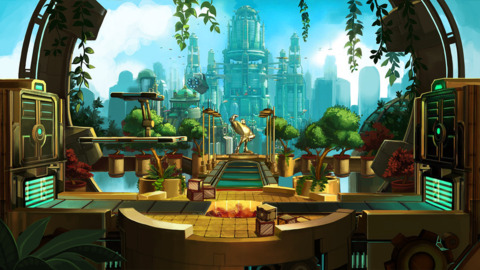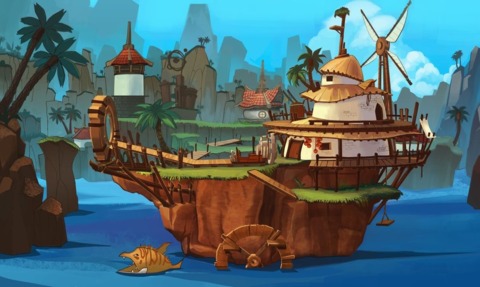Setting the Stage for a Royale Rumble
A young team tackles the PlayStation pantheon: SuperBot Entertainment talks about the development of PlayStation All-Stars Battle Royale.
SuperBot Entertainment occupies two squat, unassuming buildings amid a quiet business plaza in Culver City, California. Inside, the developers behind PlayStation All-Stars Battle Royale--an upcoming brawler starring numerous PlayStation icons--are entering the home stretch. Finding the right setting to showcase the all-stars has been no small feat for the young studio. With over three years behind them, the team has gone through a lot of experimentation to reach the state their game is in today. Now, the end is finally in sight.
Fallout 4 Next Gen Update Comparison Stellar Blade - Hard Mode No Damage Gigas Boss Gameplay Stellar Blade - Hard Mode No Damage Abaddon Boss Gameplay Stellar Blade - (Almost) All Outfits Granblue Fantasy: Relink - New Content Trailer Modern Warfare III - New Season 3 Reloaded Modern Warfare Zombies Update River City Girls 2 - New Playable Characters DLC Reveal!! That Time I Got Reincarnated as a Slime ISEKAI Chronicles – Official Announcement Trailer MEGATON MUSASHI W: WIRED – Official OP “MUSASHI English Ver.” Trailer Gothic 1 Remake | Official Collector's Edition Trailer SaGa Emerald Beyond – Official Launch Trailer Paper Mario: The Thousand-Year Door – Official Switch Overview Trailer
Please enter your date of birth to view this video
By clicking 'enter', you agree to GameSpot's
Terms of Use and Privacy Policy
The inside of SuperBot looks like a massive studio apartment turned game studio. The majority of each building's single room is dedicated to rows of computers. A kitchenette sits off to one side, and a few conference rooms are scattered along the walls. There are no partitions separating the work stations on the main floors, creating an open work space where team members can freely talk with one another.
Under the watchful eye of Guru, a massive, multi-armed robot mural, the 110 employees are hard at work putting the finishing touches on their studio's breakout game, PlayStation All-Stars Battle Royale. This mascot brawler stars a host of familiar faces from across the Sony lineup. Similar to its contemporaries, the game has simple controls. All you have to do is press a button and direction together to perform a special attack. Where it differs is in its energy meter, super attacks, and scoring system. But it wasn't always this way. The story of SuperBot and All-Stars begins over three years ago.
Chan Park, president of SuperBot Entertainment, remembers the early days of the company. Before starting work on All-Stars, SuperBot was an incubated team within Sony Santa Monica. Back then they were called Broodworks, with a humble staff of just under 30 people. Being an incubated team meant Santa Monica provided the office space, equipment, and other resources, freeing Broodworks to focus solely on game development. As the two teams collaborated, it was ultimately decided that Park and his young team would take on the mantle of the all-stars with a full, retail release.
Straight out of the gate the team's first challenge was finding the right vehicle to showcase the cast. It went through dozens of ideas, many focusing on a single-screen, multiplayer experience. In fact, All-Stars started out a more casual game. The idea of a capture-the-flag game, with combat as a secondary function, was thrown around a lot. However, another idea that was equally pervasive was the mascot brawler. As weeks passed, the brawler idea gained more and more traction--until it ultimately won out. At that point, the team knew it would need specialized help.
"Implementing and executing a winning strategy is where the fun in fighting games is born." -- KendallEnter Omar Kendall, game director for PlayStation All-Stars Battle Royale. With his past experience developing fighting games, and the connections he had made within that genre, he was a natural fit. "Once we figured out what the game was going to be, and what that core combat loop was like, then it became a matter of finding the team who could take that experience and make a whole, proper game out of it," said Kendall.
"It was very challenging to find the right talent," Park recalled. "[The fighting game genre] is something where you really need to find experienced people, and even then it is a very specific learning curve." Kendall added that it was difficult to fill some of the key positions--gameplay programming, animation, design--with those who had worked on fighting games before. "We have been fortunate to find some young, hungry, and talented people to fill out this team."
Three months after Kendall joined, another proof-of-concept was completed, and the team moved into its current space one month later. "Omar nailed everything down," said Ivan Glaze, the game's senior producer. When Glaze was brought on in 2010, the game was still in preproduction, and the team was exploring some very different ideas. "Once Omar came in, he said this is what we're going to do, and this is how we will be different from other games out there--and that really helped."
We prototyped all kinds of different things," adds Michael Bilodeau, the game's lead level designer. These prototypes included dozens of ideas that never saw the light of day, including one where characters raced along the inside of a sphere. As the game's concept became concrete, Bilodeau focused on character control first, and designing levels around those parameters second. What the players are actually doing needs to feel the best, he stated, and the stages need to accommodate that.
Fallout 4 Next Gen Update Comparison Stellar Blade - Hard Mode No Damage Gigas Boss Gameplay Stellar Blade - Hard Mode No Damage Abaddon Boss Gameplay Stellar Blade - (Almost) All Outfits Granblue Fantasy: Relink - New Content Trailer Modern Warfare III - New Season 3 Reloaded Modern Warfare Zombies Update River City Girls 2 - New Playable Characters DLC Reveal!! That Time I Got Reincarnated as a Slime ISEKAI Chronicles – Official Announcement Trailer MEGATON MUSASHI W: WIRED – Official OP “MUSASHI English Ver.” Trailer Gothic 1 Remake | Official Collector's Edition Trailer SaGa Emerald Beyond – Official Launch Trailer Paper Mario: The Thousand-Year Door – Official Switch Overview Trailer
Please enter your date of birth to view this video
By clicking 'enter', you agree to GameSpot's
Terms of Use and Privacy Policy
"Building these stages starts with research. This means playing through Uncharted, BioShock, God of War, and other games whenever there's free time. "I played through the most recent Ratchet & Clank on lunch breaks the first month I was here just to get a refresher," Bilodeau added. As they play, Bilodeau and the team are looking for basic game elements that they can isolate and construct a level around. Those ideas are then brainstormed, documented, and made into a visually simple "block out" where the idea can be tested in-game. "We burn through a ton of those," Bilodeau said. "The best are then brought to Omar and the rest of the team where we can start working on how to make them work in the game proper."
"Game design is fundamentally problem-solving all the time. You get a goal very easily; achieving that goal is the hard part." -- BilodeauIn January of 2011, art director Lee Harker was brought on board. At that time, Harker recalled, the project was just getting off the ground. His first task was addressing how the characters would look. Opinions were mixed about whether to keep the characters close to their original designs or to create a unified design for the entire cast.
The final call was a compromise: the characters' physical designs would stay true to their native games, while the ancillary details--texture, lighting, surface quality--would be unified. This means, for example, that the way Raiden, Sackboy, and PaRappa react to light is the same, giving them the appearance that they all belong in the same location.


Doug Prior, audio lead, hails from Sony Santa Monica and has been with the team for about a year. When he joined, the game's art style and combat mechanics were coming together, but the audio design was "an empty canvas." After collaboration between Prior and the rest of the team, the idea for audio mash-ups was born. Since every stage in All-Stars is a mash-up of two games--such as the Uncharted 3/BioShock Infinite stage--it seemed appropriate that the music followed suit. As Prior explained, when the stage starts, only one track will be playing. Then, once the stage mash-up begins, there will be a bridge segment where the two tracks will match beats and overlap. Finally, the first track will fade out, and the second will take over.
One unresolved issue is how to handle move-specific barks. In many fighting games, when characters perform a special attack--such as Ryu's hadoken--he or she will call out the name of the attack or give some other audio cue. Presently, the characters in All-Stars don't do this. Prior explained that when you're battling with four other people, having everyone call out move names every single time creates a lot of noise and confusion. Testing is still ongoing to find the right balance.
"We kept the fact that we are creating an introductory experience for some players in mind." -- KendallToday, Park, Kendall, and many of the department leads are busy reviewing and refining every element in the game. The ideas are set, now the team must be sure they are right for the game so the final vision is not diluted. In the beginning, when the team was much smaller, sweeping changes and big cuts were not an issue. But now, as the team has grown and the game's November release draws near, those course corrections are not so easy. Each element in the game must be watched very closely to make sure it falls within their goals. And some of those elements are still being cut.
One example that didn't fall in line was dying from level hazards. As Kendall explained, attacks from the stage itself--such as the Patapon's arrows and Hades' energy wave--would kill players on contact. This proved to be overwhelming for most players. And because dying was so frequent, the significance was devalued; most players just didn't care when it happened. An alternative was decided where instead of killing a player, background attacks would knock out some of the character's energy meter as orbs that anyone could collect. This ties in naturally to the game's focus on energy and supers. "The game made sense on a whole new level with that change," Park added.
"We are a studio that has been purpose-built to make this experience," Park said. Throughout all the prototyping, revisions, and even leaks, Park and Kendall remain confident in the team they have assembled and the product SuperBot has created. They have brought the game to numerous trade shows, and the private beta through PlayStation Network is ongoing. The data and feedback collected is analyzed and adapted into the final product, which the team hopes will do their lineup justice. But all that hinges on the game's release, just a few short months away.
For more coverage on PlayStation All-Stars Battle Royale check out the Dante and Nariko character breakdowns, or the Raiden and Heihachi video demos. The game will be released on PlayStation 3 and PlayStation Vita in North America on Novermber 20th.
Got a news tip or want to contact us directly? Email news@gamespot.com



Join the conversation